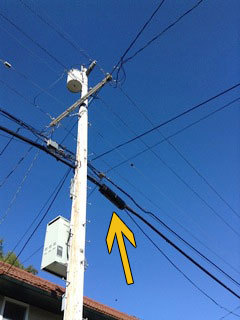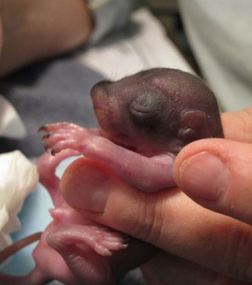WildCare's Wildlife Hospital treats nearly 4,000 ill, injured and orphaned wild animal patients from over 200 species every year. This is one patient's story.
The mother of these two tiny orphans was no exception, and she probably thought she had found the perfect spot to raise her little ones -- a cozy tube perched securely on wires atop a tall pole.
But the mother squirrel didn't know that this was a cable splice box for AT&T, and that periodically technicians would be pulling the box apart to make repairs.
When this happened, the poor mother squirrel panicked and fled, and the AT&T technicians found two tiny, pink baby squirrels curled together in a nest of leaves and grass. No doubt they were scratching their heads wondering what to do with these squirming babies now that mom had disappeared.
Fortunately a neighbor overhead them discussing what to do, and knew to call WildCare.
A lot of discussion followed between the caring neighbor and our hotline operator. (The AT&T repairmen returned to their work after making sure the baby squirrels were in good hands.) Our hotline operator, with the help of our squirrel expert was trying to determine if this squirrel family could be reunited.
Whenever possible, WildCare tries to reunite orphaned babies with their mothers. Our dedicated Foster Care volunteers do a tremendous job raising orphaned animals in the Wildlife Hospital, but we know that mom provides even better care. If it made sense, we hoped to get these babies back to their mother.
 However, there were several obstacles to reuniting this squirrel family. First, the original nest had, by necessity, been removed from the cable splice box. Most mother squirrels maintain more than one nest for just such a contingency, but we didn't know where the other nest might be.
However, there were several obstacles to reuniting this squirrel family. First, the original nest had, by necessity, been removed from the cable splice box. Most mother squirrels maintain more than one nest for just such a contingency, but we didn't know where the other nest might be.
Secondly, the pole was located at a very traffic-heavy intersection. If the mother squirrel had another nest on the same side of the busy street, she might be able to safely transport her babies. But if the other nest was across the road, the odds of her getting both her babies safely to their new home were very slim.
Finally, the location of the pole also meant there was nowhere to place the orphaned babies that would be easy for Mom to find, but that wouldn't be accessible to pedestrians, dogs and other potential threats. Very often when a nest of babies is placed in a quiet area very close to the original location of the nest, the mother squirrel will quickly come down to collect her young. However, this situation didn't offer such a safe location for the little ones.
After much discussion, and after the neighbor reported no sign of the mother squirrel, it was finally decided that these two babies would become WildCare's first foster care baby squirrels of 2014.
Caring for orphaned squirrels
These orphans are approximately 10 days old. How do we know? A squirrel's umbilicus drops off at about 10 days, and these babies lost theirs within a day of arriving at WildCare.
When babies this young enter WildCare Foster Care, they require a lot of attention. For their first weeks they are fed every three to four hours, around the clock. In addition, babies this young are not able to urinate or defecate on their own-- the mother squirrel licks them to stimulate them to eliminate. This is probably an adaptation to help mother squirrels keep their nests clean, and it's another element of care our Foster Care providers must give their mammal babies (although we use Kleenex for the purpose!) In the video below, we demonstrate how we stimulate a tiny baby squirrel to urinate. All in a day's work for a WildCare Foster Care volunteer!
WildCare is a 501(c)3 nonprofit organization supported almost entirely by private donations and individual memberships. Visit us online at wildcarebayarea.org.

